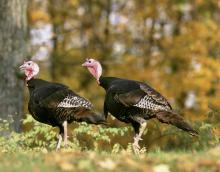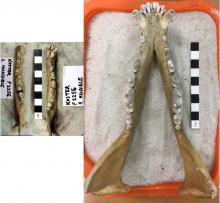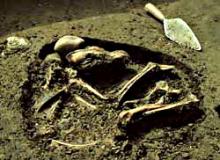Management of Animals
Some archaeologists have suggested that people may have managed animal populations during the Archaic Period. Management of populations could include practices such as improving the habitat for a particular species or not hunting female animals during the reproductive season to ensure the growth of the population. Attempts to demonstrate management often include assessment of the numbers, ages, and sexes of the animals in a faunal assemblage.
Archaeozoologists are reviewing evidence for potential Archaic Period management of turkey populations in the Eastern United States. We currently have no evidence for management of turkeys in the Illinois area during the Archaic Period. Image taken by Steve Maslowki, United States Fish and Wildlife Service, PIXNIO, Public Domain.
Some zooarchaeologists have suggested that prehistoric peoples may have managed turkeys (Meleagris gallopavo) in the Eastern United States. There is evidence that turkeys were managed or domesticated in Mesoamerica by 2,300 years ago and in the Southwestern United States by 2,200 years ago.
Dr. Tanya Peres of our research team and Kelly Ledford have argued that late prehistoric Mississippian peoples in the Southeastern United States may have managed turkeys around 1,000 years ago. You may remember from our Clues from Bones section that turkeys are sexually dimorphic. The males are much larger than the females. Peres and Kelly measured the turkey bones and discovered that both female and male turkey remains were present in Mississippian assemblages. The numbers of males present was equal to or greater than the numbers of females. The absence of medullary bone (See Clues from Bones section) in bones from females, suggests that females were not taken during the egg-laying period.
They argue that the lower representation of females and absence of females taken during the egg-laying season could represent management of turkey populations. However, it could also represent a greater focus on the hunting of large adult males because they yield more meat and feathers. The Mississippian sites are much younger than our Archaic Period sites. These researchers are recording measurements for turkey bones from Archaic Period sites to explore if there is any evidence for earlier management practices.
The faunal assemblages from Modoc and Koster include turkey bones, but they are not abundant. Zooarchaeologists did not attempt to determine the sex for turkeys based on bones from Modoc and Koster so we cannot address whether hunters took fewer females. We currently have no evidence that Archaic Period people in the Illinois area managed turkeys. However, we did not systematically look for evidence as a part of our grant project. Future researchers may want to do this work.
Archaic Period hunters took white-tailed deer of all ages including fawns. We have no evidence that Archaic Period people in the Illinois area managed deer herds by avoiding fawns or female deer of reproductive age. Image taken from ForestWander Nature Photography, Wikimedia Commons.
From time to time, biologists and archaeologists have suggested that prehistoric hunters in the Eastern United States practiced conservation of deer herds by sparing young animals. Since that time, zooarchaeologists showed that bones from old and young deer of both sexes are present in many archaeological sites. In addition, experimental studies by Dr. Patrick Munson and others have shown that dogs may totally consume bones from young deer. This destruction of less dense bones from young animals would result in an under-representation of young animals at archaeological sites.
Deer bones are abundant at Archaic Period sites, including Modoc and Koster. Although rigorous population studies of deer have not been completed for Modoc or Koster, there appear to be remains from young and older individuals of both sexes.
As part of our grant, we examined evidence for greater destruction of less dense deer bone. For Modoc Rock Shelter, we did not find evidence for destruction of less dense deer bones. For Koster, we did find a slight positive correlation between the density of deer bones and the number present at the site for the late Middle Archaic and Late Archaic deposits. At Koster, preservation of bones in the Late Archaic deposits is not as good as for earlier deposits. Less dense bones may have been destroyed by natural processes. Preservation of bones in the late Middle Archaic is excellent. Could domestic dogs have consumed less dense deer bones in the late Middle Archaic deposits? The proportion of deer bones with definite evidence for carnivore gnawing is low so we currently cannot answer this question.
We don't find evidence that suggests that Archaic Period people attempted to manage deer herds in the Illinois area through selective hunting, such as avoiding fawns or females of reproductive age. However, Dr. David Asch has suggested that Middle Archaic and later groups in the lower Illinois River valley may have managed hickory trees. They may have created clearings around trees to increase nut productivity. If they were creating clearings, then that would have benefited deer by creating more edge.
Middle Archaic hunters and gatherers along the Cumberland River of Tennessee relied on aquatic gastropods. They may have tended gastropod beds to ensure their productivity. Image provided by Tanya Peres.
Dr. Tanya Peres, a member of our research team, and her colleagues have argued that Middle Archaic Period people in the Cumberland River drainage of Tennessee may have practiced a form of aquaculture. Aquatic gastropods are extremely abundant and dominate the faunal remains at some Middle Archaic sites in the Cumberland River drainage. Dr. Peres argues that Middle Archaic peoples may have tended the gastropod beds to ensure their productivity. She is exploring this exciting hypothesis.
Domestication of Animals
Early Archaic Period people in Illinois clearly kept domestic dogs (Canis familiaris). This practice continued throughout the Archaic, later prehistory, and through the historic period. Recent research suggests that dogs may have been independently domesticated in Europe and East Asia from wolves about 15,000 years ago. Paleoindians likely brought domestic dogs to the New World. Recent work at a Siberian archaeological site discovered 9,000 year old bones of domestic dogs. The researchers proposed these dogs may have been bred to pull sleds. zooarchaeologists are studying the DNA of early dogs in search of evidence of breeding for specific traits and interbreeding with wild canids such as wolves and dogs.
In this section we will describe the domestic dogs present at Koster and Modoc. We will discuss ideas about how Archaic Period people may have interacted with dogs in the Special Use of Animals section.
Early Archaic Period people at the Koster site buried the intact dog in a shallow basin (Feature 2256). It is not clear if the artifacts near the dog's skull were in the same pit with the dog. Image used with the permission of the Center for American Archeology.
Koster, Modoc Rock Shelter, and numerous other Archaic Period sites have remains from domestic dogs. The animals are definitely recognizable as domestic dogs. Measurements of the mandibles, skulls, and postcranial elements show morphologies that differ from wild canids such as wolves and coyotes. The adult dogs from Archaic Period sites in Illinois are definitely smaller than adult wolves. Genetic research of early domestic dog remains from Illinois is underway and will help clarify relationships among early domestic dogs and wild canids.
According to zooarchaeologist Dr. Darcy Morey and archaeologist Dr. Michael Wiant, three adult domestic dogs were excavated from the late Early Archaic (Horizon 11) pit features at the Koster site. Dr. Morey identified the dogs as two males and a female. Charcoal associated with the dog burial in Feature 2256 was previously radiocarbon dated to 8,470 + 110 RCYBP (late Early Archaic).
Paleontologist Dr. Chris Widga submitted a bone sample from the dog burial from Koster Feature 2256 for Accelerator Mass Spectrometry (AMS) radiocarbon dating of purified collagen in the bone. It yielded a radiocarbon assay of 8,789+30 RYBP. He also submitted a bone sample for the Koster dog from Feature 2357. It yielded an AMS radiocarbon assay of 8,820 + 30 RCYBP. Both of these dates for these bones are earlier than the previous radiocarbon dates based on charcoal. They are also a little earlier than our start date of 8,700 RCYBP for the late Early Archaic in our Eastern Archaic Cultural Chronology Ontology (see Past Environments section). However, the types of artifacts present in Horizon 11 support the late Early Archaic assignment. The new AMS dates confirm that the Koster dog burials are among the oldest dog burials in North America.
Drs. Morey and Wiant report that the Koster dogs are represented by whole skeletons, and the bones are in correct anatomical position. There are no cut marks on any of the dog bones in the burials. The absence of cut marks and the correct anatomical position of the bones, suggest that the dogs were buried while the animals were still intact. The dogs appear to have been buried on their sides in shallow, basin-shaped pits. The dog in Feature 2256 (see image above) had a metate and mano near its skull. Archaeologists were unable to determine if these grinding tools were present before the dog was buried or were interred in the same pit with the dog. A fourth Archaic Period dog skeleton was reported for Koster, but its context was not clearly described.
Dr. Paul Parmalee recorded in his notes that archaeologists excavated two dog burials at Modoc Rock Shelter in the 1950s. A dog skeleton (listed as Dog #2, Catalog No. 2217) was excavated in the Modoc Main Shelter in 1953. According to Dr. Parmalee’s notes, the dog burial was recovered at grid locus 35L50 at 168-174 inches below ground surface (23-23.8 feet below the site datum). Paleontologist Dr. Chris Widga and Veterinarian Dr. Dennis Lawler recently examined the dog remains and determined that the bones are from an adult male. Dr. Widga submitted a sample of bone from Dog #2 for AMS radiocarbon dating of purified collagen from the bone. It yielded an assay of 7,600 + 77 RCYBP, which indicates this dog is from the early Middle Archaic.
Archaeologists excavated remains of another domestic dog (Catalog No. 6090), in the West Shelter at Modoc in 1956. According to Dr. Parmalee’s notes, it was discovered while backfilling the excavation at grid locus 45L90 at 21-22 feet below the site datum. Drs. Widga and Lawler recently examined the remains and reported that the bones are from an adult female. They submitted a sample of bone for this skeleton for AMS dating of purified bone collagen. The AMS date of 4,843 + 56 RCYBP indicates that this dog is from the late Middle Archaic.
We will discuss the roles these early dogs may have played in the Special Use of Animals section.






